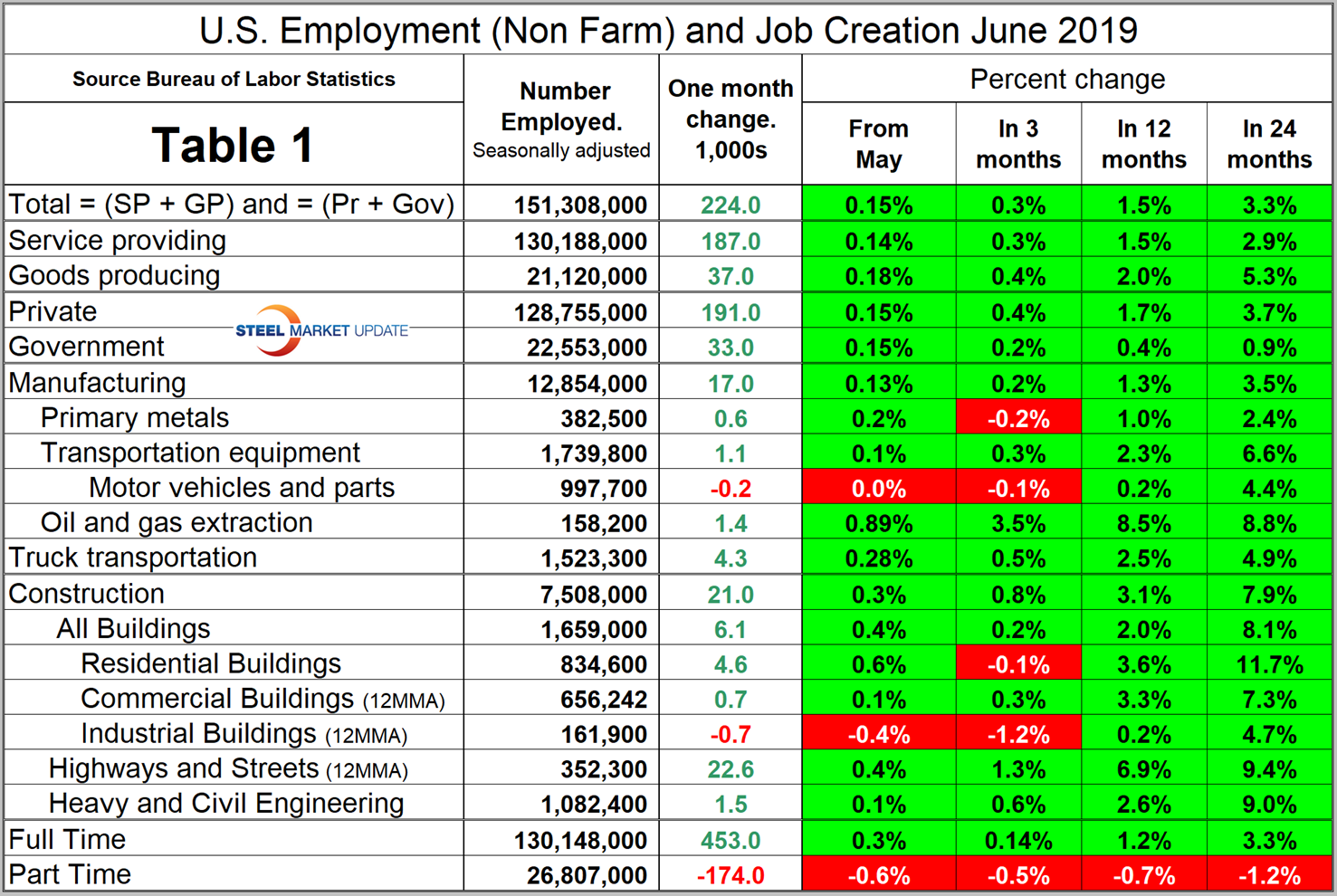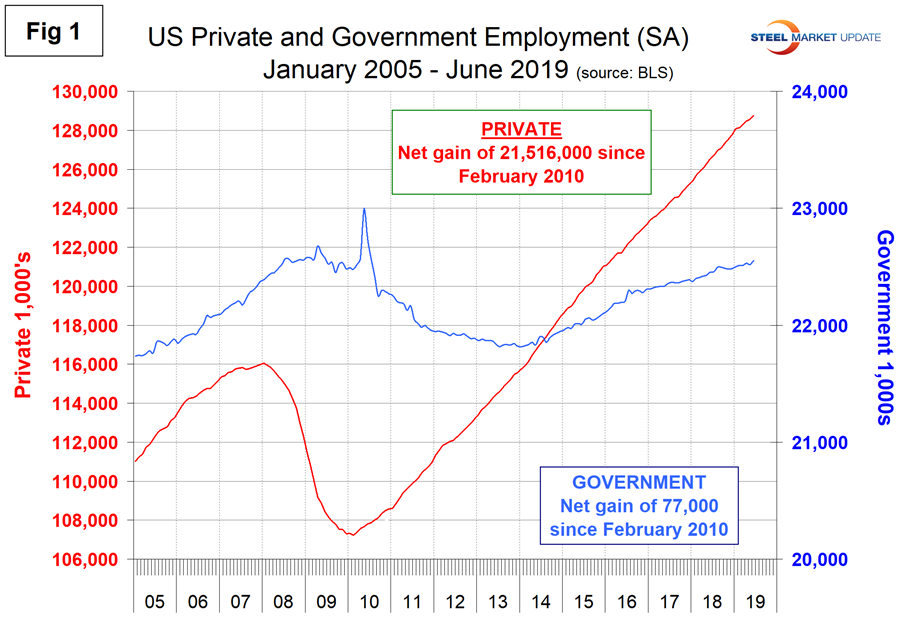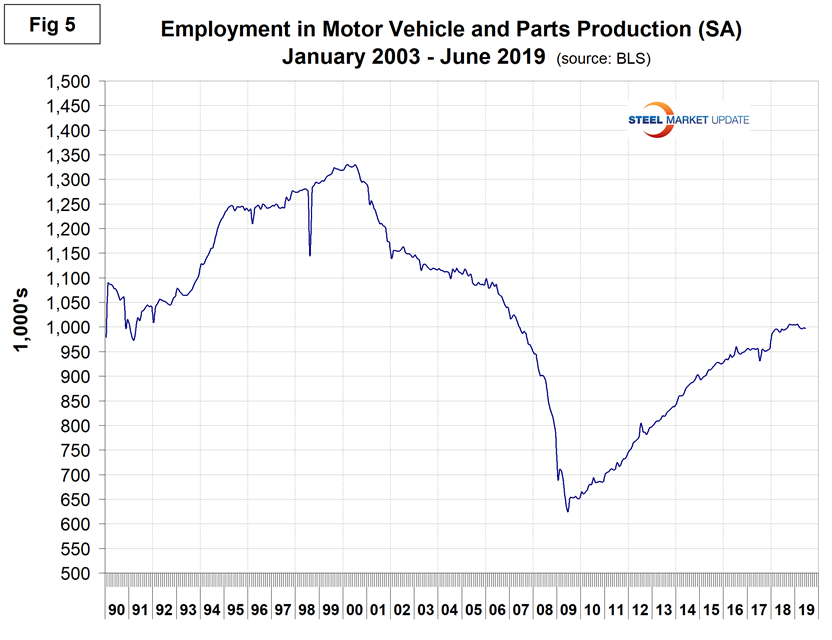Economy

Employment by Industry Through June 2019
Written by Peter Wright
July 12, 2019
In the last 12 months the rate of job creation in the primary metals industries has been slower than in manufacturing as a whole, according to Steel Market Update’s analysis of Bureau of Labor Statistics (BLS) data.
In June, 191,000 jobs were created in the private sector and government gained 33,000 positions. Table 1 breaks total employment down into service and goods-producing industries and then into private and government employees. Most of the goods-producing employees work in manufacturing and construction and the components of these two sectors of most relevance to steel people are broken out in Table 1.

In June, the number employed by the federal government increased by 2,000. State governments also gained 2,000 and the local level gained 29,000. Since February 2010, the low point of total nonfarm payrolls, private employers have added 21,516,000 jobs as government has gained 77,000 (Figure 1).

In June, service industries expanded by 187,000 as goods-producing industries, driven by construction and manufacturing, gained 37,000, (Figure 2). Since February 2010, service industries have added 18,100,000 and goods-producing 3,493,000 positions. This has been a drag on wage growth since the recession as service industries on average pay less than goods-producing industries such as manufacturing. The good news is that in the last 24 months the rate of job creation in goods-producing industries on a percentage basis has been higher than in service industries.

Construction was reported to have gained 21,000 jobs in June as manufacturing gained 17,000. Since and including January 2018, construction has added 415,000 and manufacturing 309,000 jobs. Manufacturing productivity improved by 1.2 percent in Q1 2019. Figure 3 shows the history of construction and manufacturing employment since June 2005. Construction has added 2,008,000 jobs and manufacturing 1,401,000 since the recessionary employment low point in February 2010.
The Associated General Contractors of America said in June that workforce shortages are limiting the number of new construction jobs being added in many locations. They urged federal officials to boost funding for career and technical education programs and enact immigration reforms. New education funding would make it easier for schools to set up construction-focused programs while immigration reform would allow more people with construction skills to legally enter the country. “The growing construction sector would also be supporting more high-paying middle-class jobs in this country if firms could only find more workers to hire,” said Stephen E. Sandherr, the association’s chief executive officer. “Making it easier to prepare and attract more people into the industry will provide significant benefits to the broader economy.”

Note, the subcomponents of both manufacturing and construction shown in Table 1 don’t add up to the total because we have only included those with the most relevance to the steel industry.
Table 1 shows that primary metals gained 600 jobs in June, and in the last 12 and 24 months has gained on a percentage basis less than manufacturing as a whole. Figure 4 shows the history of primary metals employment since January 2003.

Motor vehicles and parts industries were reported to have lost 200 jobs in June for a 12-month gain of 2,000. Figure 5 shows the history of motor vehicles and parts job creation.

Trucking gained 4,300 jobs in June, resulting in a 12-month gain of 36,800. Employment in truck driving is one of SMU’s recession monitors and Figure 6 suggests that at the present time the economy is still strong.

SMU Comment: Goods-producing industries have been generating jobs at a faster rate than service industries in all four time frames in Table 1. This is very good news for both steel manufacturing and consuming industries. In the last 12 months, private employers generated jobs at a rate over four times faster than did the combined three levels of government. The June job creation report was a bounce back from the dismal May result. A single month’s employment data should never be used as a gauge of the economy because of the extreme volatility of the numbers. As recently as January 2019, the primary metals industries were creating jobs at a higher rate than manufacturing as a whole on a year-over-year basis. This has not been the case in the last five months.
Explanation: On the first or second Friday of each month, the Bureau of Labor Statistics releases the employment data for the previous month. Data is available at www.bls.gov. The BLS employment database is a reality check for other economic data streams such as manufacturing and construction. It is easy to drill down into the BLS database to obtain employment data for many subsectors of the economy. The important point about all these data streams is the direction in which they are headed.

Peter Wright
Read more from Peter WrightLatest in Economy

ISM September survey captures deepening manufacturing gloom
The Institute for Supply Management’s (ISM) latest monthly report on manufacturing reflects a bleak view of American industry in September.

Key industries concerned over government shutdown’s impact on steel, manufacturing
Trade groups cautioned that a prolonged shutdown could strain US industry.

Chicago Business Barometer catches cold winds of contraction in September
The Chicago Business Barometer's September reading indicates a softening in overall business activity in the Midwest for the third consecutive month, with new orders and backlogs retreating further.

Metalforming market sentiment takes a dive in September: PMA
Metalforming manufacturers anticipate a decrease in near-term conditions, according to the Precision Metalforming Association's (PMA) Business Conditions Report for September.

AIA: Architecture firms still under pressure
Architecture firms reported a modest improvement in billings through August, yet business conditions remained soft, according to the latest Architecture Billings Index (ABI) release from the American Institute of Architects (AIA) and Deltek.
